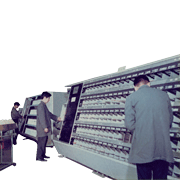Developed by Tokyo Shibaura Denki (today Toshiba), the TR-3 and TR-4 mail sorters were presented to the public at the Tokyo Central Post Office on July 1, 1968, the day the postal code system was inaugurated. They were the world’s first practical mail sorters to recognize and sort mail items by postal code written in ordinary handwritten numbers.
The red boxes for entering the postal code digits were a unique specification to Japan. The numbers entered in the red boxes provided a home position as a necessary signal for character recognition, so that the readers optically picked out just the lines making up the numbers inside the boxes. The difficulty faced in developing the mail sorters was the huge range of variations in handwriting, due to the writing implement, the size and position of numbers, and thickness and density of the strokes. Toshiba collected more than 300,000 samples of handwritten numbers from across the country and used them in analytic simulations to gradually improve the mail sorters’ accuracies. The company was eventually successful in developing the practical TR-3 (with 50 sorting slots) and TR-4 (with 100 sorting slots).
The basic specifications of the TR-3 and the TR-4 were as follows:
- Recognize ordinary handwritten numbers entered in red boxes
- Able to read three digits per mail item
- Able to process 20,000 mail items per hour
- The TR-3 had 52 sorting slots in four rows and the TR-4 had 100 sorting slots in five rows
- Feature extraction used superimposition scanning and recognition used a parallel penalty automaton


